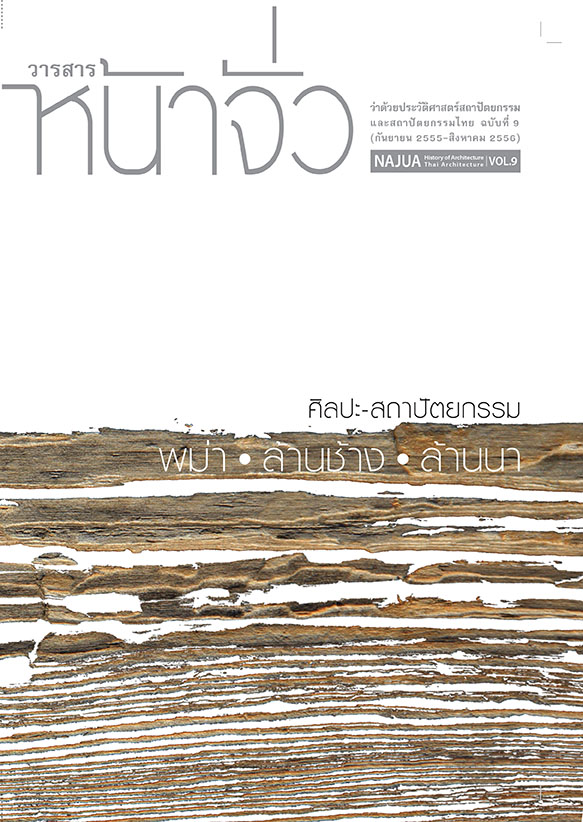สภาพแวดล้อมกับการตั้งถิ่นฐานที่บางกอก Environment and the Settlement in Bangkok
Main Article Content
Abstract
บทคัดย่อ
ภายหลังมหาอุทกภัยในที่ราบภาคกลางเมื่อปี พ.ศ. 2554 ได้เกิดกระแสความเชื่อในสังคม ซึ่งได้รับการสนับสนุนจากทั้งนักวิชาการ และผู้เชี่ยวชาญในสาขาเกี่ยวกับการจัดการสิ่งแวดล้อมด้านต่างๆ ว่า เหตุแห่งความทุกข์ยากจากน้ำที่ชาวภาคกลางประสบนั้นเป็นผลของแบบแผนการตั้งถิ่นฐานสมัยใหม่ ซึ่งไม่คำนึงถึงลักษณะทางภูมิศาสตร์ของพื้นที่มีการถมคลอง ท้องร่อง ตัดถนน ปลูกอาคารขวางทางน้ำ สร้างเขื่อนริมตลิ่งลำน้ำลำ และทำประตูขวางกั้นปากคลองอย่างกว้างขวาง ซึ่งเป็นการเปลี่ยนแปลงภูมิประเทศดั้งเดิมไปอย่างสิ้นเชิง สิ่งที่ตามมาก็คือ การเสียสมดุลของระบบนิเวศและความขัดแย้งกันระหว่างรูปแบบการดำรงชีวิตของผู้คนกับสภาพแวดล้อมธรรมชาติ ซึ่งส่งผลร้ายนานาประการ
ขณะเดียวกันก็เกิดกระแสชื่นชมยกย่องแบบแผนการตั้งถิ่นฐานในอดีต ซึ่งมองกันว่าสอดคล้องต้องกันกับสภาพธรรมชาติของที่ลุ่มต่ำอุดมไปด้วยน้ำ เช่น การปลูกเรือนแบบยกพื้น เรือนแพ การทำนาโคลนตม การทำสวนยกร่อง รวมถึงการขุดคลองเป็นเส้นทางคมนาคม แหล่งรับน้ำ และทางระบายน้ำสำหรับชุมชนเมือง ภาพพระนครในต้นคริสต์ศตวรรษที่ 20 และก่อนหน้านั้น ถือเป็นแบบอย่างที่ดีของการตั้งถิ่นฐานที่เหมาะสมกับภูมิภาคนี้ การมีคูคลองมากมายก็ดี การตั้งบ้านเรือนแบบสะเทิ้นน้ำสะเทิ้นบกตามชายน้ำก็ดี ตลอดจนการปรับวิถีการดำรงชีวิตไปตามสภาพน้ำท่วมน้ำหลากก็ดี ล้วนแต่ชวนให้เข้าใจว่า พระนครเป็นเมืองที่เกิดขึ้นมาอย่างผสานกลมกลืนกับสภาพดั้งเดิมของท้องถิ่นอันเป็นที่ตั้งเป็นอย่างมาก
ความเข้าใจดังกล่าวเป็นที่ยอมรับกันทั่วไป จนกลายเป็นกระแสหลัก ซึ่งสอดรับกับกระแสความรู้สึกหวนหาอดีตของสังคมในปัจจุบัน คำถามที่เกิดขึ้นก็คือ ความเข้าใจที่ว่านี้สอดคล้องกับความเป็นไปในอดีตมากน้อยเพียงใด ในการตอบคำถามดังกล่าว บทความนี้สำรวจภูมิศาสตร์และประวัติศาสตร์ของการตั้งถิ่นฐานในพื้นที่แถบลุ่มน้ำเจ้าพระยาตอนล่าง โดยเน้นที่ย่านบางกอก ในช่วงก่อนคริสต์ศตวรรษที่ 19 เพื่อทำความเข้าใจแบบแผนความสัมพันธ์ระหว่างสภาพแวดล้อมกับการตั้งถิ่นฐาน ซึ่งวิวัฒน์ไปตามกาลเวลา บทความเสนอข้อสรุปว่า การตั้งถิ่นฐานชุมชนชาวนาชาวสวน และชุมชนในป่าชายเลน มีความสอดคล้องกับระบบนิเวศท้องถิ่นเป็นอย่างมาก ขณะที่การตั้งถิ่นฐานชุมชนเมืองที่บางกอกนั้น นับแต่แรกตั้ง ก็มีความแปลกแยกจากสภาพภูมิประเทศอันเป็นที่ตั้งเมือง และแปลกแยกจากพื้นที่รอบข้างอย่างเห็นได้ชัด ทั้งในทางกายภาพ ประชากร เศรษฐกิจ สังคม และการเมือง ชุมชนเมืองที่บางกอกมิได้ถูกสร้างให้ผสานกลมกลืนกับสภาพดั้งเดิมของท้องถิ่นอันเป็นที่ตั้ง ตรงกันข้าม ชุมชนเมืองแห่งนี้คือเติบโตขึ้นพร้อมๆ กับความแปลกแยกแตกต่างกับพื้นที่รอบข้าง และในเวลาต่อมา รัฐก็ส่งเสริมความแปลกแยกแตกต่างนั้นยิ่งขึ้นAbstract
After the recent great flood in Thailand during the late 2011, there has been a strong belief among the general public, supported by academics and experts in environmental management fields, that what caused the disaster in the central plain was largely the modern development pattern which is against the area’s topography. The modern development projects have typically involved filling up of waterways and building roads, dams and water gates that totally transforms the area’s natural landscape and the natural flow of water. As a result, the degradation of the once-balanced ecosystem is inevitable. The conflict between the modern lifestyle and the environment is evident and this leads to many detrimental effects.
At the same time, another equally strong belief in line with the former has also occurred. It has been widely seen that the old settlement pattern, which is characterised by the extensive waterway networks, floating and lifting houses, flooded rice cultivation and ditch-dyke landform of orchards, is the one that is most suitable to the central plain wetland. Considering the urban area, the old Bangkok during the early twentieth century and before is a good example of how human settlement could lie properly on the water-rich landscape. The sophisticated canal system, the aquatic dwellings of city residents and the water-resilient lifestyle all assure that the old Bangkok was deliberately built to fit its environment.
Although the belief has been prevalent and become mainstreamed, a question remains-whether the old settlement pattern is really built in congruence, environmentally and socially, with the area it is situated. The paper tries to answer this question. It is an enquiry into the geographical and historical background of the settlement in the lower Chao Phraya river basin during the time before the nineteenth century with the specific interest in the old Bangkok. The paper concludes that the rural settlements by farmers, gardeners and people in mangrove forests were by and large ecologically harmonious with the environment where they were located. But the old Bangkok was not. Since established in the sixteenth century, it was apparently alienated from its surrounding in all physical, demographic, economic, social and political terms. The city was not deliberately built to appropriate its environment. In contrast, it had grown with the ever-increasing degree of alienation against its environs. The state had acknowledged this and acted to reinforce the alienation.

